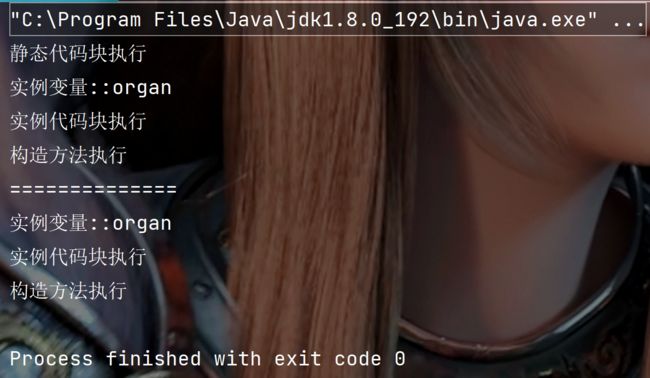【Java】构造方法及类的初始化
活动地址:CSDN21天学习挑战赛
![]() ✨博客主页: XIN-XIANG荣
✨博客主页: XIN-XIANG荣
✨系列专栏:【Java SE】
✨一句短话: 难在坚持,贵在坚持,成在坚持!
文章目录
- 一. 利用构造方法给对象初始化
-
- 1. 构造方法的概念
- 2. 构造方法的特性
- 3. 子类构造方法
- 4. 避免在构造方法中调用重写的方法
- 二. 对象的默认初始化
- 三. 就地初始化对象
- 四. 类的初始化顺序
-
- 1. 普通类(没有继承关系)
- 2. 派生类( 有继承关系)
一. 利用构造方法给对象初始化
1. 构造方法的概念
构造方法(也称为构造器)是一个特殊的成员方法,其名字必须与类名相同,在创建对象时,由编译器自动调用,并且在整个对象的生命周期内只调用一次。
构造方法的作用就是给对象中的成员进行初始化,并不负责给对象开辟空间。
public class Date {
public int year;
public int month;
public int day;
// 构造方法:
// 名字与类名相同,没有返回值类型,设置为void也不行
// 一般情况下使用public修饰
// 在创建对象时由编译器自动调用,并且在对象的生命周期内只调用一次
public Date(int year, int month, int day) {
this.year = year;
this.month = month;
this.day = day;
System.out.println("Date(int,int,int)方法被调用了");
}
public void printDate() {
System.out.println(year + "-" + month + "-" + day);
}
public static void main(String[] args) {
// 此处创建了一个Date类型的对象,并没有显式调用构造方法
Date d = new Date(2021, 6, 9);
// 输出Date(int,int,int)方法被调用了
d.printDate(); // 2021-6-9
}
}
2. 构造方法的特性
- 名字必须与类名相同
- 没有返回值类型,设置为void也不行
- 创建对象时由编译器自动调用,并且在对象的生命周期内只调用一次
- 绝大多数情况下使用public来修饰,特殊场景下会被private修饰
- 构造方法可以重载(用户根据自己的需求提供不同参数的构造方法); 下面两个构造方法:名字相同,参数列表不同,因此构成了方法重载
public class Date {
public int year;
public int month;
public int day;
// 无参构造方法
public Date(){
this.year = 1900;
this.month = 1;
this.day = 1;
}
// 带有三个参数的构造方法
public Date(int year, int month, int day) {
this.year = year;
this.month = month;
this.day = day;
}
public void printDate(){
System.out.println(year + "-" + month + "-" + day);
}
public static void main(String[] args) {
Date d = new Date();
d.printDate();
}
}
- 如果用户没有显式定义,编译器会生成一份默认的构造方法,生成的默认构造方法一定是无参的; 一旦用户定义,编译器则不再生成;下面代码中,没有定义任何构造方法,编译器会默认生成一个不带参数的构造方法。
public class Date {
public int year;
public int month;
public int day;
public void printDate(){
System.out.println(year + "-" + month + "-" + day);
}
public static void main(String[] args) {
Date d = new Date();
d.printDate();
}
}
- 构造方法中,可以通过this调用其他构造方法来简化代码
【注意事项】
- 构造方法中,通过this(…)去调用其他构造方法,这条语句必须是构造方法中第一条语句
- 多个构造方法不可以互相调用(不能形成环), 会形成构造器的递归调用,但却没有调用的结束条件
public class Date {
public int year;
public int month;
public int day;
// 无参构造方法--内部给各个成员赋值初始值,该部分功能与三个参数的构造方法重复
// 此处可以在无参构造方法中通过this调用带有三个参数的构造方法
// 但是this(2022,8,16);必须是构造方法中第一条语句
public Date(){
//System.out.println(year); 注释取消掉,编译会失败
this(2022, 8, 16);
//this.year = 1900;
//this.month = 1;
//this.day = 1;
}
// 带有三个参数的构造方法
public Date(int year, int month, int day) {
this.year = year;
this.month = month;
this.day = day;
}
}
3. 子类构造方法
在继承基础上,子类对象构造时,需要先调用基类构造方法,然后执行子类的构造方法。
在子类构造方法中,并没有写任何关于基类构造的代码,但是在构造子类对象时,先执行基类的构造方法,然后执行子类的构造方法,
原因在于:子类对象中成员是有两部分组成的,基类继承下来的以及子类新增加的部分 。父类和子类, 肯定是先有父再有子,所以在构造子类对象时候 ,子类构造方法中先要调用基类的构造方法,将从基类继承下来的成员构造完整 ,然后再完成子类自己的构造,将子类自己新增加的成员初始化完整 。
【注意事项】
- 若父类显式定义无参或者默认的构造方法,在子类构造方法第一行默认有隐含的super()调用,即调用基类构造方法
public class Base {
public Base(){
System.out.println("Base()");
}
}
public class Derived extends Base{
public Derived(){
// super(); // 注意子类构造方法中默认会调用基类的无参构造方法:super(),
// 用户没有写时,编译器会自动添加,而且super()必须是子类构造方法中第一条语句,
// 并且只能出现一次
System.out.println("Derived()");
}
}
public class Test {
public static void main(String[] args) {
Derived d = new Derived();
}
}
- 如果父类构造方法是带有参数的,此时需要用户为子类显式定义构造方法,并在子类构造方法中选择合适的父类构造方法调用,否则编译失败。
public class Animal {
public String name;
public int age;
public Animal(String name, int age) {
this.name = name;
this.age = age;
System.out.println("Animal(String , int )");
}
}
public class Dog extends Animal{
//傻狗 是狗的属性
public boolean silly;
public Dog(String name,int age,boolean silly) {
//1. 先帮助父类部分初始化 必须放到第一行
super(name,age);
this.silly = silly;
System.out.println("Dog(String ,int ,boolean )");
}
public static void main(String[] args) {
Animal animal2 = new Dog("金毛",6,false);
}
}
- 在子类构造方法中,super(…)调用父类构造时,必须是子类构造方法中第一条语句。
- super(…)只能在子类构造方法中出现一次,由与this(…)调用时也要在第一条语句,所以super(…)不能和this(…)同时出现,也就是是说子类构造方法中不能使用this(…)
4. 避免在构造方法中调用重写的方法
一段有坑的代码. 我们创建两个类, B 是父类, D 是子类. D 中重写 func 方法. 并且在 B 的构造方法中调用 func
class B {
public B() {
// do nothing
func();
}
public void func() {
System.out.println("B.func()");
}
}
class D extends B {
private int num = 1;
@Override
public void func() {
System.out.println("D.func() " + num);
}
}
public class Main {
public static void main(String[] args) {
D d = new D();
}
}
执行结果:
- 构造 D 对象的同时, 会调用 B 的构造方法.
- B 的构造方法中调用了 func 方法, 此时会触发动态绑定, 会调用到 D 中的 func
- 此时 D 对象自身还没有构造, num 处在未初始化的状态, 值为 0;如果具备多态性,num的值应该是1.
- 所以在构造函数内,尽量避免使用实例方法,除了final和private方法。
【结论】:
“用尽量简单的方式使对象进入可工作状态”, 尽量不要在构造器中调用方法(如果这个方法被子类重写, 就会触发动态绑定, 但是此时子类对象还没构造完成), 可能会出现一些隐藏的但是又极难发现的问题.
二. 对象的默认初始化
在Java方法内部定义一个局部变量时,用户必须要将其赋值或者初始化,否则会编译失败;
但对象中的字段(成员变量),用户不需要将其初始化就可直接访问使用,这里其原因在于new对象时,jvm会给出字段的默认初始化。
下面是new对象是时,jvm层面执行的概述:
- 检测对象对应的类是否加载了,如果没有加载则加载
- 为对象分配内存空间
- 处理并发安全问题
比如:多个线程同时申请对象,JVM要保证给对象分配的空间不冲突 - 初始化所分配的空间
即:对象空间被申请好之后,对象中包含的成员已经设置好了初始值
| 数据类型 | 默认值 |
|---|---|
| byte | 0 |
| short | 0 |
| int | 0 |
| long | 0 |
| float | 0.0f |
| double | 0.0 |
| char | /u0000 |
| boolean | false |
| reference (引用类型) | null |
- 设置对象头信息(关于对象内存模型后面会介绍)
- 调用构造方法,给对象中各个成员赋值
三. 就地初始化对象
在声明成员变量时,就直接给出了初始值。
代码编译完成后,编译器会将所有给成员初始化的这些语句添加到各个构造方法中
public class Date {
public int year = 1900;
public int month = 1;
public int day = 1;
public Date(){
}
public Date(int year, int month, int day) {
}
public static void main(String[] args) {
Date d1 = new Date(2022,8,16);
Date d2 = new Date();
}
}
四. 类的初始化顺序
1. 普通类(没有继承关系)
- 静态部分(静态变量、常量,静态代码块)
- 在类加载阶段执行,类中存在多个静态部分时,会按顺序执行
- 静态代码块只会执行一次,且静态的变量、常量等只会创建一份
- 非静态部分(实例变量、常量、实例代码块)
- 当有对象创建时才会执行,按顺序执行
- 最后执行构造方法,当有对象创建时才会执行
代码演示:
class Person {
public String name;
public int age;
public Organ organ = new Organ();
public Person(String name, int age) {
this.name = name;
this.age = age;
System.out.println("构造方法执行");
}
{
System.out.println("实例代码块执行");
}
static {
System.out.println("静态代码块执行");
}
}
class Organ {
//...
public Organ() {
System.out.println("实例变量::organ");
}
}
public class TestDemo {
public static void main(String[] args) {
Person person1 = new Person("xin",21);
System.out.println("==============");
Person person2 = new Person("xinxin",20);
}
}
执行结果:
2. 派生类( 有继承关系)
- 静态部分(静态变量、常量,静态代码块)
- 父类静态代码块优先于子类静态代码块执行,且是最早执行
- 只有第一次实例化子类对象时,父类和子类的静态部分会执行; 之后再实例化子类对象时,父类和子类的静态部分都不会再执行
- 父类非静态部分(实例变量、常量、实例代码块)和父类构造方法
- 子类非静态部分(实例变量、常量、实例代码块)和子类构造方法
class Person {
public String name;
public int age;
public Person(String name, int age) {
this.name = name;
this.age = age;
System.out.println("Person:构造方法执行");
}
{
System.out.println("Person:实例代码块执行");
}
static {
System.out.println("Person:静态代码块执行");
}
}
class Student extends Person{
public Student(String name,int age) {
super(name,age);
System.out.println("Student:构造方法执行");
}
{
System.out.println("Student:实例代码块执行");
}
static {
System.out.println("Student:静态代码块执行");
}
}
public class TestDemo4 {
public static void main(String[] args) {
Student student1 = new Student("张三",19);
System.out.println("===========================");
Student student2 = new Student("gaobo",20);
}
public static void main1(String[] args) {
Person person1 = new Person("bit",10);
System.out.println("============================");
Person person2 = new Person("gaobo",20);
}
}
执行结果:

